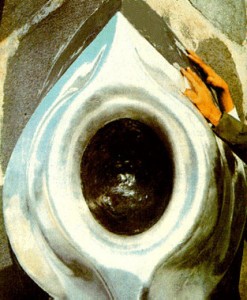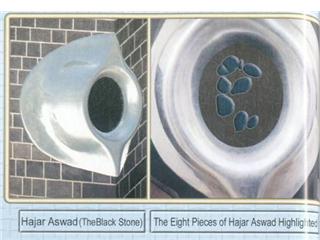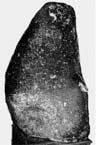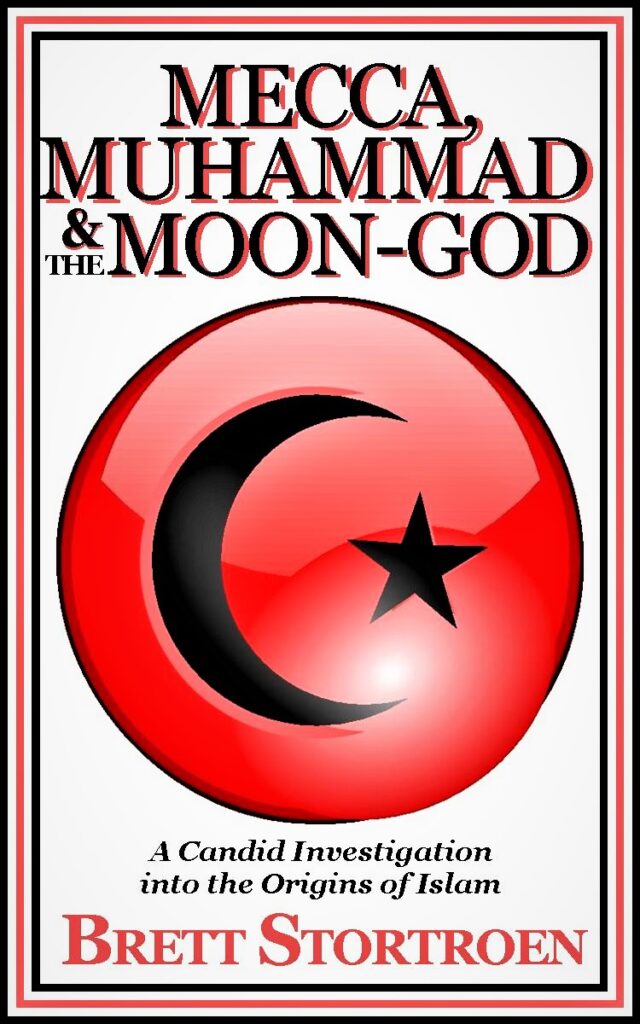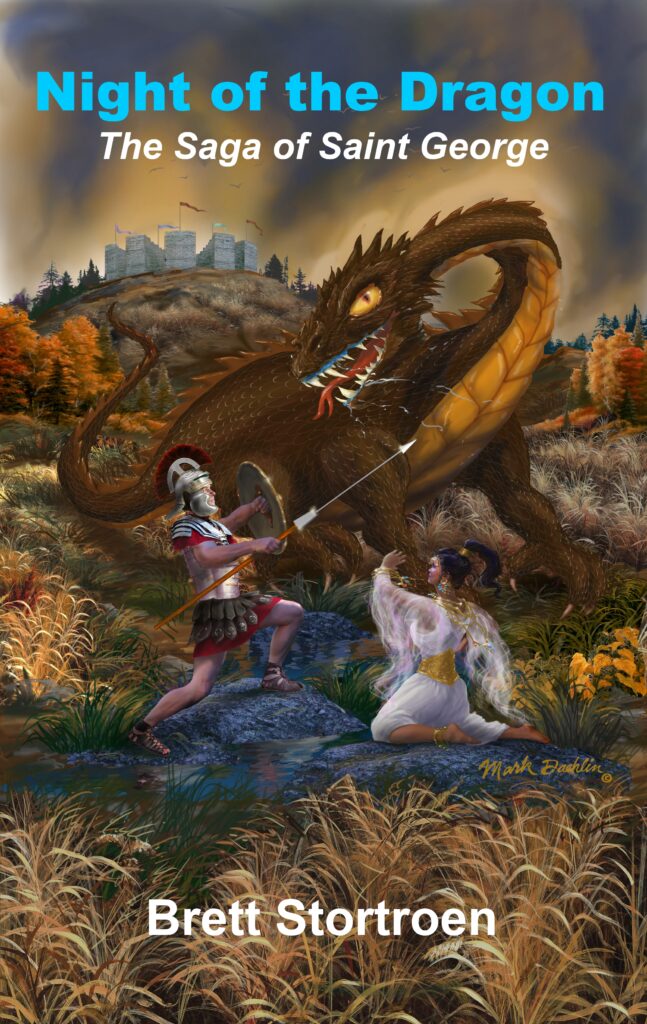“The Lord will drive you and the king you set over you to a nation unknown to you or your fathers. There you will worship other gods, gods of wood and stone. You will become a thing of horror and an object of scorn and ridicule to all the nations where the Lord will drive you.” Deut. 28:36-37
HISTORY OF THE BLACK STONE
An aura of mystery lingers around the Black Stone located in Mecca and concealed away mystically in the precincts of Kabah. Its mystic origin remains permeated and enmeshed with legends and fables. Lingering in a limbo of traditions and pagan taboos, the Black Stone becomes a myth in an age of science and reasoning; its influence stems back to ancient days of black magic and barbaric heathenism. The torrential blood of thousands rage as a turbulent river, a beaconing cenotaph to the call of Allah’s fury and wrath around the world.
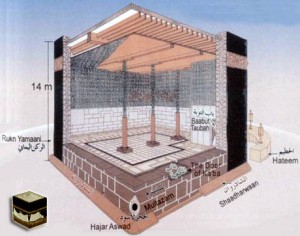 Historical Descriptions
Historical Descriptions
The oldest detailed description of the Black Stone came from the Muslim historian Azraqi. During ibn az-Zubayr’s occupation, he gave an account in 683-84 C.E. of the siege of Mecca. The army of Yazid, the Umayyad, assaulted the holy city Mecca with flaming arrows. One of the arrows set fire to the Kabah and completely destroyed it. In the aftermath, the Black Stone had been cracked into three large pieces.[1]
In addition, a splinter had chipped off and was kept by the Banu Shayba for many years. F.E. Peters, in his book The Hajj, quoted the historian Azraqi:
Ibn al-Zubayr held it together with silver nails, except for the splinter from off its top, whose position is clear at the top of the stone. The length of the stone (rukn) is two cubits and it occupies the thickness of the kabah wall. “I heard some who described the color of its rear face inside the wall. Some said it was rosy, others it was white.”[2]
While another account from the time of ibn al-Zubayr said that they had measured the stone to be three cubits, other witnesses also described it as intensely white, except for the external side.[3] The Christian writer John of Damascus, who had lived in a Muslim controlled region sometime during the early eighth century, gave the next historical testimony to the “White Stone.” John spoke fluent Arabic and was very familiar with the Qur’an and the Hadith. He believed the White Stone was the head of the statue Aphrodite, whom the Arabs worshipped and called Khabar (Great). John said, “Even to the present day, traces of the carving are visible on it to careful observers.”[4]
During 930 C.E., the Qarmatians stormed into Mecca, seized the Stone and brought it back to al-Hasa or Bahrayn, where they guarded it. A ransom was offered for it but was ignored. Then twenty-one years later, according to the historian Juwayni, the Black Stone was thrown into the Friday Mosque of Kufa with a written message: “By command we took it and by command we have brought it back.”[5] The White Stone was stolen, consisting of three distinct pieces, but it was returned in seven separate pieces. In the Encyclopedia of Islam, an interesting question was proposed: Did the Qarmatians deliberately break the White Stone in order to bring the number of pieces in line with the new age of the seven Imams?[6] This seems plausible since they were a Gnostic sect who had robed themselves in an Islamic guise. Furthermore, they believed in the doctrine of the seven Imams and were practitioners in the seven degrees of initiation.[7]
According to Grunebaum, in Muhammadan Festivals, another fragment was broken off in 1932 by an Afghan pilgrim. For this act of insolence King ibn Saud decreed immediate execution for the perpetrator and then he personally rejoined the piece of the fragment.[9]
Why Did the Stone Turn Black?
There are several reasons put forth to explain the change in the Stone’s color. The most common view proclaims that it was due to “the fingering of menstruating women.”[30] This is verified by Peters as he quotes the Sufi ibn al-Arabi:
The Black Stone signifies the spirit. . . . Its turning black from the touching of menstruating women and its disappearance and its becoming troubled and angry by reasons of the idle chatter of the mental faculty in preference to the heart and its becoming master over it.[31]
A second variant tradition states, it “became black because of menstruating women and polluted persons mounted up to it and rubbing it with their hands.”[32] A third interpretation has been based on the Stone’s function as a cosmic register of human degradation. Consequently, the Stone is believed to be darkened and stained by the sins of mankind.[33] A more divergent fourth view teaches the Stone was meant to be black. Due to its absence of light, it became a perfect symbol “of the essential spiritual virtue of poverty for God (faqr), . . . an emptiness of God,”[34] or the necessary extinction of the ego. This tradition likely comes from Sufi or Buddhist source
Captain Richard Burton’s Description
In September of 1853 C.E., the famous explorer, Captain Richard Burton, while in disguise, was able to remain ten minutes with the Black Stone. From his own written account, Personal Narrative of a Pilgrimage to Al-Madinah & Mecca, Burton gives the following keen observation:
I narrowly observed it, and came away persuaded that it was an aerolite (meteorite). It is curious that almost all travelers agree upon one point, namely, that the stone is volcanic. Ali Bey calls it mineralogically a block of volcanic basalt, whose circumference is sprinkled with little crystals, pointed and straw-like, with rhombs of the tile-red feldspath upon a dark background, like velvet or charcoal, except one of its protuberances, which is reddish. Burkhardt thought it was a lava containing several small extraneous particles of a whitish and of a yellowish substance.[10]
Burton continues to elaborate another detailed summary:
It appeared to me a common aerolite (meteorite) covered with a thick slaggy coating, glossy and pitch-like worn and polished. Dr. Wilson, of Bombay, showed me a specimen in his possession, which externally appeared to be a black slag, with the inside of a bright and sparkling grayish-white, the result of admixture of nickel [p.301] with the iron.[11]
Modern Descriptions
Several modern descriptions of the Black Stone add further insight into its composition. Grunebaum relates a typical analysis from the year 1951:
The Black Stone, variously described as lava, basalt and an aerolite, and actually of a dark red-brown color, is built into the eastern corner, about five feet above ground. Split in a conflagration, it now consists of three large and several small pieces tied together by a silver band. Its diameter is estimated at twelve inches.[12]
The Encyclopedia of Islam elaborates further:
This is a stone set in the southeast corner of the kabah about 1.5 yards/meter from the ground. It is black with reddish tones and yellow particles, of ovoid shape about 11 inches/28cm wide and 15 inches/38cm high, set in silver chasing.[13]
This particular testimony may give credence to the testimony by John of Damascus, because of its ovoid shape and its similarity in size to a typical statue head of a pagan goddess, Astarte. Mircea Eliade, in The Encyclopedia of Religion, detailed another perspective:
The most important object at the Ka’bah is located on the exterior: This is the Black Stone (al-hajar al-aswad) embedded in the eastern corner. Actually dark red-brown, and now encased in a massive silver band, the black stone is of unknown origin, possibly meteoric.[14]
All three of these modern descriptive accounts are similar. Regardless, the exact scientific origin of the Stone remains dubious. Was the Stone a hybrid of an ancient silica glass permeated with elements of nickel-iron from a fallen meteor impact? Perhaps a thorough investigation by an expert geological team could solve the mystery. Was there a scientific explanation for why the Stone morphed from white to black? Or, perhaps, the original White Stone that Muhammad venerated was actually stolen by the Qarmations and substituted with the current Black Stone. Muslims still debate why the Stone turned black. What is hidden within the Stone’s encasement? Why is only a small portion of the Stone revealed to the public? Does the hole in the Black Stone imply any past sexual fertility cultic function? These mysteries remain hidden and concealed due to superstition and secrecy.
The Black Stone was not the only stone venerated at the Kabah. In the exact opposite corner, and placed a little lower in position, resided a stone reddish in color and called the “Stone of Felicity” (hajar sa adah).[15] There was also a stone called the “Station” or “Standing Place” of Abraham which is said to have miraculously preserved his footprints. Finally, there remained the paradox concerning the veneration of the Kabah itself as Eliade remarked:
Between the Black Stone and the raised door is a section of exterior wall known as the multazan, where worshippers press their bodies . . . in order to receive the barakah (“blessing, power”) associated with the holy house.[16]
The Black Stone and other similar objects were venerated as gods. All these pre-Islamic stones were considered holy, but the Black Stone remained the chief object of veneration in Kabah.
Muhammad’s Veneration/Worship of the Black Stone
After a long absence from Mecca, Muhammad returned to the holy city to perform his last Hajj (pilgrimage). According to ibn Abbas in the Hadith, “A group of atheists had circulated the news that a group of people were coming to them, and they had been weakened by the fever of Yathrib (Madina).”[37] In consideration of this, the prophet ordered his companions to do as he did. He first kissed the corner of kabah where the Black Stone was located and then he walked by prancing the first three rounds, most likely to demonstrate that they were not weak from travel or disease. They proceeded then to walk the remaining four circumambulations.[38]
Evidently, according to Abdullah bin Umar in the Hadith, Muhammad always practiced this style of prancing, both for Hajj and Umra. He also performed the circumambulation between the hills Safa and Marwa.[39] Both of these customs were performed in the exact manner by the pre-Islamic Arabs at Mecca and have extreme pagan overtones. Sometimes Muhammad performed the ritual riding on a camel. Every time he passed the corner of the Black Stone, he pointed towards it with a bent-headed stick and exclaimed: “Allah is the greatest.”[40] The use of his stick is reminiscent of how he subsequently destroyed the 360-plus idols in the Kabah. Muhammad stood near them and pointed at them with a stick and declared, “The truth has come and falsehood has passed away” (Qur’an 17:81). Next, they collapsed on their backs one after another.[41] These stone idols obviously represented an astral cult which included a god for every day of the year.
One of Muhammad’s close companions, Umar bin al-Khattab, had observed him (Muhammad) kissing and touching the Black Stone, and was startled. Abes bin Rabia narrated in the Hadith the account of Umar bin al-Khattab conversing to a venerated stone, a form of idolatry:
No doubt, I know that you are a stone and can neither benefit anyone nor harm anyone. Had I not seen Allah’s Apostle kissing you I would not have kissed you.[42]
A few of Muhammad’s close followers appeared skeptical towards several of his customs. In spite of this fact, they just obeyed and deferred the authority to their beloved leader. Muhammad simply evaded the overt pagan implications by creating outlandish new dogma. For instance, he proclaimed that the Lord gave the Muslims the Hajj and Holy War (Jihad) in exchange for monasticism.[43]
Orthodox Practice in the Veneration of the Black Stone
The customary practice regarding the Black Stone ritual has for the most part, remained unchanged since the time of Muhammad. The Stone was to be kissed when passing it; if the crowd makes this impossible, it was to be touched with the hand or staff, and “the touch transferred to the face.”[44] As previously mentioned, there resided another stone in the opposite “Yemenite corner” called the “Stone of Felicity.” Yet, this stone was only to be touched and not kissed, which indicates the superior stature of the Black Stone.
THE PRE-ISLAMIC CULTUS OF SACRED STONES
STONES OF THE ANCIENT WORLD
Sacred Stones had been venerated all over the world from the dawn of mankind. They were employed as objects for sacrifices, magical rites, and divination.
There were certain stones that had been constructed or raised up by man for specific rituals. These included monuments shaped like pillars or columns, which had been given various names from Celtic origin. Eliade described these types of stones:
Menhirs (tall, upright monumental stones): cromlechs (circles of standing stones); dolmens (table stones or large, flat, unhewn stones resting horizontally on upright ones); and cairns(heaps of stones).[1]
In addition, natural rocks with unique shapes or characteristics are often given sacred status. Smaller portable stones may be used as cult objects in the home, as well as, carried or worn on the body as magical protection. Stones that are small enough to carry about every day on one’s person are referred to as amulets or talismans.[2]
More specifically, there were shooting and falling stars, meteors, and meteorites, which were often believed to have come from the heavens, either good or evil.[3] These mysterious stones which fell to earth were called by the ancients “thunder stones” or “animated stones.” It was believed they could float on water by the sound of a trumpet or sink into the ground as impious names were uttered. Furthermore, some considered these stones to be inhabited by certain deities; therefore, they were enshrined in temples or venerated at the sites where they had been discovered.[4]
Stones of North and South American Indians
Sacred stones and rocks along with their spirits were highly venerated by the American Indians. Beginning with the South American Indians, the Puruha of Ecuador offered human sacrifices to a volcano, and among the Indians of the Andes stone worship was quite common.[5] Stone gods were discovered on the island of Lake Titicaca in Bolivia/Peru. Here the Indians venerated black stones in the temple of the sun. They believed that Oregano, the mother-goddess of mankind, came and brought these stones from the planet Venus.[6] Moreover, “The supreme being of the Warao of the delta of the Orinoco”[7] was worshipped as a stone.
Likewise, the North American Indians practiced stone worship and was described by Eliade:
The Dakota have decorated and painted great boulders, praying to them and sacrificing dogs upon them. The Crow keep small, animal-shaped stones as powerful medicine. The Algonquin around Lake Mistassini in Canadadare not cross the waters before having sacrificed to the spirit who inhabits a massive, anomalous block. Southward, in the United States, higher, personalized gods are also believed to dwell in stones. The Kiowa in Texaspossess a little stone god to whom they pray during the Sun Dance. The Tao in New Mexicovenerate at the foot of a sacred mountain the “stone men” who represent two war gods. The Pueblo Indians believe that the hunter’s good luck depends on his possession of stones of a curious shape.[8]
The stone cults of the American Indians exemplified in the text exactly parallel the pre-Islamic stone veneration customs.
Stones of Ancient Greece and Asia Minor
In addition to the Indian stone cults, the Greeks and those further to the east also had similar rituals. A few examples of these stone cults demonstrated below confirm these practices.
The Ancylus of the Romans
This object was a mass of meteoric iron that fell around 700 B.C.E. during the reign of Numa Pomphilius. The Sibylline Books prophesied that the loss of this stone would inaugurate the fall of Rome.[9]
The Stone of Aphrodite (left)
The sacred black stone represented as the goddess Aphrodite from Paphos, Cyprus. Worshiped as early as the 12th century BC.
The Stone of Apollo
This stone was the most popular sacred stone of ancient Greece. It was black, conical shaped, hard and heavy, and believed to be a meteorite. It had been considered the omphalos (navel) at Delphi. The poet Pindar (522-438 B.C.E.) believed “that the sanctuary of Delphi is situated at the exact center of the earth.”[10] This correlates precisely with the Islamic view that the Kabah is the central point of worship upon the earth. Robert Charroux, in Masters of the World, recited a legend concerning the stone of Apollo:
Helenius, son of Priam and a famous Greek soothsayer, could foretell the future by means of a stone that had been given to him by Apollo. To obtain the oracle of the gods, he shook the stone above his head and recited incantations. The stone then spoke in a strange, faint voice and announced the future.[11]
The Stone of Diana at Ephesus
Traditionally, the statue of the goddess and the stones of the temple were believed to have fallen from the sky. Worship was directed to Diana-Artemis, and it is uncertain as to whether she was from the planet Venus or the Moon. Diana was considered the sister of Apollo, “The Gwyon and the Bel-Heol of the Celts, and Hermes of the Egyptians.”[12]
The Stone of Cybele
This stone’s mass consisted of iron that was believed to be a meteorite and was associated with the goddess Cybele of the Phrygians. Eliade gave a historical description of the stone:
It arrived in Rome in 204 B.C.E., when Rome was being threatened by Hannibal. The Sibylline Books, which had been consulted after a meteor shower, foretold that a foreign army could be driven from Italy if Cybele’s symbol, a meteorite, was brought to Rome. It was, and Hannibal was defeated. The Romans expressed their gratitude to the goddess by erecting a temple to her on the summit of the Palatine and held an annual celebration to commemorate her arrival.[13]
 The Stone of Emessa, Syria (pictured on ancient coin to left)
The Stone of Emessa, Syria (pictured on ancient coin to left)
This stone was conical shaped and black. The Phoenicians worshipped it, but the identity of the deity represented is uncertain. Afterwards, the priestly Arabs of Emessa enshrined the holy stone of Emessa; the high priest Elagabus carried it off to Rome with him when he became emperor.
Kabahs and Shrines of Ancient Arabia
The Arabs from ancient times worshipped numerous Kabah(s), as well as, sacred temples or shrines that were called tawaghit. Each of these sacred buildings had a peculiar guardian or overseer; offerings and sacrifices were presented to these structures in addition to the expected circumambulations.[23] The Himyar, for example, had a temple in Sana called Riam to which they paid homage with dutiful sacrifices and offerings. “According to one report, they used to receive communications from an oracle therein.”[24]
The Kabah of Mecca has been venerated more than all the other Islamic holy buildings. The Hajj retains this belief evidenced by the pilgrims, pressing their bodies against its wall, in order to obtain the baraka (blessing power) that is emitted from the holy structure.[26]
Baetyls, Idols, and Images
The early residents of Arabia continued to worship as they moved to different locales, often carrying their gods with them, and setting up fixed shrines in oases. The venerated objects were usually stones, trees, and the stars, but it was the animated spirits residing within them that were worshipped.[29] As the Greek and Latin writers came into contact with Arabic culture, they encountered a widespread cult of stones. They thought it was quite strange to worship stones “whether they were totally unshaped or fashioned into some kind of rudimentary idol.”[30] According to Muslim historian ibn al-Kalbi:
Every family in Mecca had at home an idol which they worshipped. Whenever one of them purposed to set out on a journey, his last act before leaving the house would be to touch the idol in hope of an auspicious journey; on his return, the first thing he would do was to touch it again in gratitude for a propitious return.[31]
Likewise, the Muslim historian ibn-Ishaq gave the same account. Except, he described the man rubbing the idol instead of touching it.[32] Muhammad continued this tradition in the rituals of the Black Stone. When Muhammad touched the stone with a stick and exclaimed “Allah is the greatest,” he likely believed the deity resided within the stone, thus conforming to the common Arabian frame of mind.
Many paradoxes and contradictions reveal themselves in regard to Islamic theology. For example, why did Muhammad and his followers talk to stones in obvious adulation and reverence while rebuking others for idolatry? In like manner, the holy and sacred component attached to these stones attains confirmation by the fact that menstruating women were not supposed to come near the idols or touch them.[33] Any violation of this proscription was considered taboo in the Islamic tradition of the Hajj. Ibn al-Kalbi continued his report on early Arab customs:
The Arabs were passionately fond of worshipping idols. Some of them took unto themselves a temple around which they centered their worship, while others adopted an idol to which they offered their adoration. The person who was unable to build himself a temple or adopt an idol would erect a stone in front of any other temple which he might prefer, and then circumambulate it in the same manner in which he would circumambulate the Sacred House. The Arabs called these stones baetyls (ansab). Whenever these stones resembled a living form they called them idols (asnam) and images (awthan) The act of circumambulating them they called circumrotation (dawar).[34]
Furthermore, the idols were often statues made of wood, gold, or silver; the images were often statues made of stone, or a stone which was circumambulated to venerate as an idol.[35] Kalbi elaborated further on these customs:
Whenever a traveler stopped at a place or station (in order to rest or spend the night) he would select for himself four stones, pick out the finest among them and adopt it for his god, and use the remaining three as supports for his cooking-pot. On his departure he would leave them behind, and would do the same on his other stops. The Arabs were wont to offer sacrifices before all these idols, baetyls, and stones. Nevertheless they were aware of the excellence and superiority of the kabah, to which they went on pilgrimage visitation. What they did on their travels was a perpetuation of what they did at the kabah, because of their devotion to it. The sheep which they offered and slaughtered before their idols and baetyls were called sacrifices (atair, sing. Atirah); the place on which they slaughtered and offered the sacrifice was called an altar (itr).[36]
Idol and Baetyl Worship of Ancient Arabia
Many of the rituals surrounding both the pre-Islamic and post-Islamic Hajj were practiced throughout ancient Arabia. These included the following: Offerings and sacrifices to various idols and baetyls (ansab), swearing by the stones, circumambulations, and similar customs of enshrined sacred rocks.
In Tabalah, which takes seven nights from Mecca to journey, there resided the idol of dhu-al-Khalasah. It was a carved piece of quartz with something resembling a crown upon its head. Near the coast of Judahor in that region, there existed an idol called Sad that was described as a long rock. Another tribe, the Daws, had an idol enclosed in a shrine called dhu-al-Kaffan (he of the two palms).[37] “Some of the Azd tribe had an idol called dhu-al-shara (Dusares).”[38] This was also the main god of the Nabateans. “Its chief sanctuary was in Petra, where a large black, quadrangular unhewn stone was dedicated to it in a splendid temple.”[39] Ibn al-Kalbi described another idol:
The Tayyi had an idol called (al-) Fals. It was red (rock), in the form of a man in the center of their mountain, Aja, which was black. They were wont to worship (this rock), present their offerings unto it, and slaughter their sacrifices before its (ascent).[40]
Further north in the hills of Syria; the Quadaah, the Lakhm, the Judham, Amilah, and the Ghatafan had an idol called al-Uqaysir. They often went on pilgrimage and upon arrival would shave their heads at the shrine of the idol. A man named Zuhayr once exclaimed, “‘I swore by the baetyls of al-Uqaysir a solemn oath, where the foreparts of the heads and lice are shaven.’”[41] Notice how the god al-Uqaysir was represented by an idol in one instance and a baetyl (ansab) in another. It appeared that the form of the stone was not so important.
The Anazah had an idol called Suayr, which they used to circumambulate. A traveler by the name of Jafar came upon this idol and remarked:
My young camels were startled by the blood of sacrifice offered around Sa’ayr…go on pilgrimage and stand before it in fear and awe, motionless and silent, awaiting its oracular voice.[42]
Ibn al-Kalbi reported how many of the baetyls were actually relic stones gathered from ancient ruins by the traveling Bedouins. They would be erected, sacrificed to, and circumambulated as gods. Based upon this revelation concerning relics, John of Damascus may be correct in his assertion that the Black Stone was actually a statue head of Aphrodite’s idol.
The following compiled list of quotations comes from ibn al-Kalbi’s historical reports concerning the widespread stone cultus prevalent among the Arabic pagan culture:
The Ghani would circumrotate their baetyls every evening! . . . And I vowed by the baetyls. . . . Young lads circumambulate their baetyls, until their hair becomes grey. . . . I lead my she-camels and carry my baetyls behind me; Would that I have my people’s god beside me! . . . And I swore by the baetyls and the curtains. . . . No! By Allat and all the sacred baetyls, thou shalt not escape! . . . While I and my horse, Ward, were like baetyls smeared with the blood of sacrifice.[43]
All these historical quotations supply ample evidence of how stone worship permeated ancient Arabia.
Another testimonial to the revered status of the stone/idol cults within Arabian culture involves the common practice of naming children after certain family or clan deities. The Muzaynah, for example, had an idol called Nuhm and used to name their children abd-Nuhm in its honor. They also had a custodian of Nuhm called Khuzai ibn abd-Nuhm.[44]
It would seem important to consider the paradoxical implications of Muhammad’s own clan, the Quraysh, who were custodians of the Kabah. One of his ancestors bore the name Manaf, the sun god; and another relative took the name of al-Uzza, one of the daughters of Allah. Particularly interesting is the fact that Muhammad’s own father was called abd-Allah (slave of Allah).[45] Why did they name themselves after celestial deities? Apparently it was a religious commemoration to their astrological gods. Furthermore, was it just coincidence that Muhammad’s father bore the name of the Islamic supreme deity? Or was Allah just another celestial god among the 360-plus stone idols of the pre-Islamic Kabah pantheon?
ALLAH AS THE BLACK STONE
All these principle deities throughout Arabia were represented by a specific rock and surrounded by some kind of sacred temple or shrine. Inscriptions were commonly engraved upon the temple wall designating which deity was lord of the house. Ibn Ishaq described just one such inscription that was found in the rebuilding of the temple during Muhammad’s ministry:
I was told that Quraysh found in the corner a writing in Syriac. They could not understand it until a Jew read it for them. It was as follows: “I am Allah the Lord of Bakka, I created it on the day that I created heaven and earth and formed the sun and moon, and I surrounded it with seven pious angels. It will stand while its two mountains stand, a blessing to its people with milk and water,” and I was told that they found in the maqam a writing, “Mecca is God’s holy house, its sustenance comes to it from three directions; let its people not be the first to profane it.”[51]
Allah is considered the “high god” of the Kabah in Mecca, and is represented by the Black Stone, which was prior worshipped among the other 360-plus idols therein. It may be concluded that Muhammad discarded all the rivals to venerate his own favored god, Allah. Furthermore, Muhammad’s father bore the name Abdallah, (cf. abd-Allah spelling in last paragraph of chapter two) “slave of Allah,” and it makes sense that he would adopt his family’s personal god above all others.
During his ministry, all the idols, stones, and images were taken out of Kabah, except the Black Stone and the less important “Stone of Felicity.” This confirms the Black Stone was indeed, none other than the local Meccan “high god,” Allah. When Muhammad touched the Stone proclaiming, “Allah is the greatest,” he was addressing the moon-god deity who incarnated within it. There exists no evidence that he altered the meaning or rituals surrounding the stone cults of Arabia.
Therefore, it cannot be maintained that the Black Stone represented merely an altar or symbol. It was clear Muhammad retained the pagan rituals of stone worship. If Muhammad insisted upon exterminating the idolatry of Arabia, why did he adhere to the same idolatrous rituals? Contemporary evidence has established the fact that Muhammad had purposeful intention to destroy all rival stone cults in order to eliminate any competition with his own personal stone god, Allah.
From Chapter 1 of Mecca, Muhammad & the Origins of Islam: A Candid Investigation Into the Origins of Islam.
[1] Glasse, Encyclopedia of Islam, 214.
[2] Abu al-Walid Muhammad al-Azraqi, “Akhbar Makka,” ed. Ferdinand Wostenfeld, Die chromiken der Stadt Mecca, vol. 1, Leipzig (1858); rep. (Hildersheim: George Olms, 1981), 140-144; quoted in F.E. Peters, The Hajj: The Muslim Pilgrimage to Mecca and the Holy Places (Princeton: University Press, 1994), 63.
[3] Ibid.
[4] John of Damascus, “On Heresies,” in Saint John of Damascus: Writings, vol. 37, The Fathers of the Church: A New Translation, trans. Frederick H. Chase Jr., ed. Roy Joseph Deferrari et al. (New York: Fathers of the Church Inc., 1958), 157.
[5] Glasse, Encyclopedia of Islam, 77.
[6] Ibid., 323. [7] Ibid., 322.
[9] G.E. von Grunebaum, Muhammadan Festivals (New York: Henry Schuman Inc., 1951), 23.
[10] Richard F. Burton, Personal Narrative of a Pigrimage to Al-Madina and Mecca, vol. 2, ed. Isabel Burton (New York: Dover Publications Inc., 1964), 169.
[11] Ibid., 326.
[12] Grunebaum, Festivals, 23.
[13] Glasse, Encyclopedia of Islam, 214.
[14] Mircea Eliade, ed., The Encyclopedia of Religion, (New York: Macmillan Publishing Co., 1987), 8:225.
[15] Glasse, Encyclopedia of Islam, 214.
[16] Eliade, Encyclopedia of Religion, 8:225.
[30] Ibid. [31] Ibid., 910. [32] Ibid., 908.
[33] Eliade, Encyclopedia of Religion, 8:225.
[34] Glasse, Encyclopedia of Religion, 77.
[37] al-Boukhari, Hadith, vol. 2, no. 1616:253.
[38] Ibid., 1605:254. [39] Ibid., 1616:256. [40] Ibid., 1607:254, 1612-13:255, 1632:261.
[41] F.E. Peters, Muhammad and the Origins of Islam (Albany: State University of New York Press, 1994), 236.
[42] al-Boukhari, Hadith, vol. 2, no. 1597:251.
[43] Grunebaum, Festivals, 44.
[44] Ibid., 29.
From Chapter 2 of Mecca, Muhammad & the Origins of Islam: A Candid Investigation Into the Origins of Islam.
[1] Eliade, Encyclopedia of Religion, 14:50.
[2] Ibid. [3] Ibid., 45.
[4] Robert Charroux, Masters of the World, trans.Lowell Blair (New York: Berkely Publishing Corp., 1974), 55.
[5] Eliade, Encyclopedia of Religion, 14:53.
[6] Charroux, Masters, 55.
[7] Eliade, Encyclopedia of Religion, 14:53.
[8] Ibid.
[9] Charroux, Masters, 56.
[10] Eliade, Encyclopedia of Religion, 14:51.
[11] Charroux, Masters, 56. [12] Ibid.
[13] Eliade, Encyclopedia of Religion, 14:46.
[23] Peters, Origins, 16.
[24] Hisham Ibn al-Kalbi, The Book of Idols: Being A Translation of the Kitab Al-Asnam, trans. Nabih Amin Faris (Princeton: Princeton University Press, 1952), 10-11.
[26] Grunebaum, Festivals, 23.
[29] Peters, Origins, 12, 270.
[30] Peters, Hajj, 21.
[31] ibn al-Kalbi, Idols, 28.
[32] Peters, Origins, 15.
[33] al-Kalbi, Idols, 27.
[34] Ibid., 28. [35] Ibid., 46. [36] Ibid., 28-29. [37] Ibid., 29-32. [38] Ibid.
[39] Ibid., 33. [40] Ibid., 51. [41] Ibid., 33, 42.
[42] Ibid., 35-36. [43] Ibid., 36-37. [44] Ibid., 34.
[45] al-Tabari, The History of al-Tabari, ed. Ehsan Yar-Shater, trans. W. Montgomery Watt and M.V. McDonald, vol. 6, Muhammad at Mecca (Albany: State University of New York Press, 1988), xxx, 9, 44.
From Chapter 3 of Mecca, Muhammad & the Origins of Islam: A Candid Investigation Into the Origins of Islam.
[51] ibn-Ishaq, Life, 85-6.
http://www.bigfaithministries.com

The Islamic Black Stone by Brett Stortroen is licensed under a Creative Commons Attribution 3.0 Unported License.

